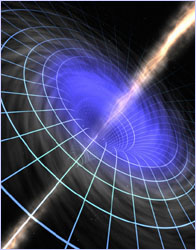
|
 |
 |
You and I know it as a time machine. Physicists, on the other hand, call it a "closed timelike curve." Below, feast on the concepts and conjectures, the dialects and definitions that physicists rely on when musing about the possibility of time travel. If this list only whets your appetite for more, we recommend you have a gander at the book from which we excerpted this glossary: Black Holes and Time Warps: Einstein's Outrageous Legacy, by Kip S. Thorne (Norton, 1994). absolute space: Newton's conception of the three-dimensional space in which we live as having a notion of absolute rest, and as having the property that the lengths of objects are independent of the motion of the reference frame in which they are measured. absolute time: Newton's conception of time as being universal, with a unique, universally agreed upon notion of simultaneity of events and a unique, universally agreed upon time interval between any two events. chronology protection conjecture: Stephen Hawking's conjecture that the laws of physics do not allow time machines. curvature of space or spacetime: The property of space or spacetime that makes it violate Euclid's or Minkowski's notions of geometry; that is, the property that enables straight lines that are initially parallel to cross. event: A point in spacetime; that is, a location in space at a specific moment of time. Alternatively, something that happens at a point in spacetime, for example, the explosion of a firecracker. exotic material: Material that has a negative average energy density, as measured by someone moving through it at nearly the speed of light. field: Something that is distributed continuously and smoothly in space. Examples are the electric field, the magnetic field, the curvature of spacetime, and a gravitational wave. freely falling object: An object on which no forces act except gravity. general relativity: Einstein's laws of physics in which gravity is described by a curvature of spacetime. geodesic: A straight line in a curved space or curved spacetime. On the Earth's surface the geodesics are the great circles. gravitational time dilation: The slowing of the flow of time near a gravitating body. gravitational wave: A ripple of spacetime curvature that travels with the speed of light. hyperspace: A fictitious flat space in which one imagines pieces of our Universe's curved space as embedded. mouth: An entrance to a wormhole. There is a mouth at each of the two ends of the wormhole. Newtonian laws of physics: The laws of physics, built on Newton's conception of space and time as absolute, which were the centerpiece of 19th-century thinking about the Universe. perturbation: A small distortion (from its normal shape) of an object or of the spacetime curvature around an object. Planck-Wheeler length: The Planck-Wheeler length (1.62 x 10-33 centimeters) is the length scale below which space as we know it ceases to exist and becomes quantum foam. principle of absoluteness of the speed of light: Einstein's principle that the speed of light is a universal constant, the same in all directions and the same in every inertial reference frame in the absence of gravity. quantum foam: A probabilistic foamlike structure of space that probably makes up the cores of singularities, and that probably occurs in ordinary space on scales of the Planck-Wheeler length and less. quantum gravity: The laws of physics that are obtained by merging ("marrying") general relativity with quantum mechanics. quantum mechanics: The laws of physics that govern the realm of the small (atoms, molecules, electrons, protons), and that also underlie the realm of the large, but rarely show themselves there. reference frame: A (possibly imaginary) laboratory for making physical measurements, which moves through the Universe in some particular manner. relative: Dependent on one's reference frame; different, as measured in one frame which moves through the Universe in one manner, than as measured in another frame which moves in another manner. simultaneity breakdown: The fact that events which are simultaneous as measured in one reference frame are not simultaneous as measured in another frame that moves relative to the first. singularity: A region of spacetime where spacetime curvature becomes so strong that the general relativistic laws break down and the laws of quantum gravity take over. If one tries to describe a singularity using general relativity alone, one finds (incorrectly) that tidal gravity and spacetime curvature are infinitely strong there. Quantum gravity probably replaces these infinities by quantum foam. spacetime: The four-dimensional "fabric" that results when space and time are unified. spacetime curvature: The property of spacetime that causes freely falling particles that are initially moving along parallel world lines to subsequently move together or apart. Spacetime curvature and tidal gravity are different names for the same thing. spacetime diagram: A diagram with time plotted upward and space plotted horizontally. special relativity: Einstein's laws of physics in the absence of gravity. tidal gravity: Gravitational accelerations that squeeze objects along some directions and stretch them along others. Tidal gravity produced by the moon and sun is responsible for the tides on the Earth's oceans. time machine: A device for traveling backward in time. In physicists' jargon, a "closed timelike curve." warpage of spacetime: Same as curvature of spacetime. world line: The path of an object through spacetime or through a spacetime diagram. wormhole. A "handle" in the topology of space, connecting two widely separated locations in our Universe. From Black Holes and Time Warps: Einstein's Outrageous Legacy by Kip S. Thorne. Copyright © 1994 by Kip S. Thorne. Reprinted by permission of W. W. Norton & Company, Inc. and Macmillan. Photo: Photodisc Imaging Sagan on Time Travel | Traveling Through Time Timespeak | Think Like Einstein | Resources Teacher's Guide | Transcript | Site Map Editor's Picks | Previous Sites | Join Us/E-mail | TV/Web Schedule About NOVA | Teachers | Site Map | Shop | Jobs | Search | To print PBS Online | NOVA Online | WGBH © | Updated November 2000 |
